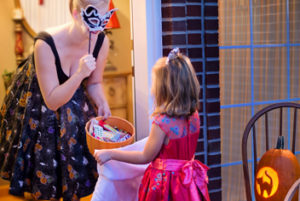How to keep your child’s Halloween safe and spook-tacular
Halloween is a spook-tacular holiday for parents and children to be fun and creative while celebrating the spirit of fall. Trick-or-treating, fall festivals, pumpkin carving and candy devouring are sure signs of October fun, but safety is key to a festive month well-done.
While there are many real-life dangers that parents may be afraid of on Halloween, taking careful precautions can help eliminate risks.
 Determine if Halloween is too scary for your young child
Determine if Halloween is too scary for your young child
Ghouls, goblins and ghost stories conjure a festive Halloween spirit in adults, but can be too scary for young children. Children ages birth to 5 may not have yet developed the mindset to differentiate imagination from reality, which can cause some holiday traditions to seem scarier than others.
Each young child is unique and is at their own developmental stage. If the holiday is too spooky for your child, leave the monsters in the closet and practice Halloween sensitivity to help your child feel more at ease.
Make sure your child is visible at night
While a moonlit sky sets the mood for Halloween ambiance, it’s imperative that parents make sure their child is visible at all times during trick-or-treating and other traditional activities. Staying visible will help prevent children from getting lost or injured. Many simple, affordable tactics can help parents make sure their child stays visible throughout the night. Flashlights, glow sticks and illuminated candy baskets are essential. To ensure maximum visibility, parents should purchase their child a bright costume that has built-in reflective components.
Always trick-or-treat with adult supervision
Organizing adult supervision and responsibilities are the first steps in mapping out a successful night of trick-or-treating. Never let children trick-or-treat without the watchful eye of at least one alert and focused adult. Refraining from cellphone usage will help parents to keep their supervision sharp. Children should never cross the street without an adult. While trick-or-treating, use the opportunity to teach children about road safety procedures. To help maintain a smooth night, plan ahead by deciding your trick-or-treating route before embarking on the night’s adventure. Choosing a path ahead of time will help to eliminate confusion. Place a name tag on all children that includes contact information in case of an emergency that a child is lost. Prevent “stranger danger” by always walking in a group and reminding children not to approach homes without lights on.
Check for costume safety hazards
Costumes are one of the most traditional and versatile ways to celebrate Halloween. Whether your child has their heart set on a fun, scary or happy costume, keep it safe. An appropriate costume length in combination with shoes that fit properly will help young children to enjoy activities without tripping. Avoid purchasing costumes that include small pieces that pose a choking hazard or sharp props that increase risk of injury. Ensure that any face masks do not obstruct vision and that face paint is nontoxic.
Handle treats properly at the end of the night
A loot of candy is the gem of any trick-or-treater’s night, but it’s important to always thoroughly inspect candy before consumption. Sift through candy, one by one, and discard any that appear to have been tampered with. Set small, hard candies aside that could pose a chocking hazard. Before trick-or-treating, make sure that children eat a healthy meal to keep them sustained and help them to not overindulge on treats. Help children avoid sugar-overload by setting parameters on how much candy they are allowed at a given time.
For free child development support, call the Birth to Five Helpline at 877-705-KIDS (5437)
or download the Birth to Five Helpline app!
All content in this article, including any advice or commentary from Southwest Human Development staff and/or others, should be considered an opinion and is provided for informational purposes only. The content is not intended to be a substitute for medical or other professional advice, diagnosis or treatment. Always seek the direct advice of your own trusted professional with any questions or concerns you may have regarding the child/ren in your care. Southwest Human Development does not recommend or endorse any specific tests, products, procedures or other information that may be mentioned in this article. You may contact Southwest Human Development’s Birth to Five Helpline at 1-877-705-KIDS (5437) to speak with one of our early childhood professionals for personalized assistance. Birth to Five Helpline specialists are available Monday through Friday from 8 a.m. to 8 p.m.
